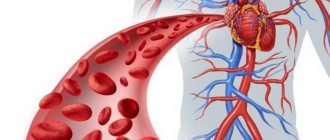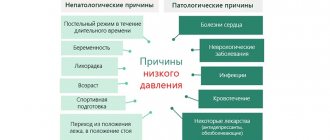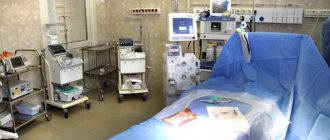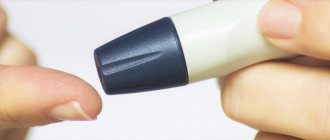General information
Carbohydrate metabolism largely determines the general state of metabolism . Carbohydrates take part in almost all types of metabolism: proteins (glycoproteins), nucleic acids (ribose/deoxyribose), lipids (glycolipids), nucleotides (ATP, AMP, ADP), nucleosides (adenosine), ions. Simple and complex carbohydrates are one of the main sources of energy that ensure the vital functions of the body and are an essential component of the diet. Disorders of carbohydrate metabolism are combined into several typical forms (groups) of pathology: hypo- and hyperglycemia , aglycogenoses , glycogenoses , hexoses and pentosemias .
Hyperglycemia is a clinical symptom characterized by an increase in blood glucose (in plasma) of more than 6.5 mmol/L on an empty stomach and more than 8.9 mmol/L at any time of the day). ICD-10 hyperglycemia code: R73.9 - Hyperglycemia, unspecified. Based on the glucose level (GLU), a mild state of 6.7-11.1 is distinguished. It is characterized by a significant and persistent increase in BPC to a level of 10.5-11.0 mmol/l and is combined with a disorder of the body’s vital functions. This kind of hyperglycemia is defined as hyperglycemic syndrome. The most severe manifestation is a hyperglycemic crisis (GPC > 16.5).
The subject of the article is early disorders of carbohydrate metabolism, which some authors define as “prediabetes”. Early disorders of carbohydrate metabolism usually include the state of impaired glucose tolerance (IGT) and impaired fasting glucose (IFG) or a combination of these conditions (IGT+IGN). It is generally accepted that prediabetes is accompanied by a high risk of developing type 2 diabetes, but in some cases prediabetes does not convert into type 2 diabetes and is assessed by a number of authors as an independent risk factor for the development of cardiovascular diseases. Essentially, these are borderline disorders of carbohydrate metabolism that precede the development of diabetes mellitus , i.e. hyperglycemia with glucose values insufficient for the diagnosis of diabetes.
It has been established that with IGN, liver insulin resistance and hyperproduction of glucose by the liver are more pronounced than with isolated IGT, which is confirmed by higher liver glucose production and the insulin resistance index. IGT is characterized by peripheral insulin resistance, confirmed by lower insulin . In cases of a combination of these conditions (IGT+NGN), the first phase of insulin secretion is disrupted.
According to the literature, the global prevalence of IGT in people aged 30 to 70 years is about 6.7% and continues to increase, and in the Russian Federation, about 19% of the active population have prediabetes, that is, these people are at risk of developing diabetes. Prediabetes, like T2DM, is associated with age and weight gain. Gender differences in the prevalence of early carbohydrate metabolism disorders have not been identified.
According to expert data, the risk of developing type 2 diabetes in people with IGT is 6 times higher than in people with normal glucose tolerance, and in cases of a combination of IGT/NGN, the risk is twelve times higher. The relative risk of overall mortality in persons with IGT is 1.48 times higher than normal, while the risk of cardiovascular complications increases by 1.66 times. In the presence of IFN, the risk of developing T2DM is 4.7 times higher than in persons with normal glucose tolerance. IFN is also associated with a relatively high risk of developing cardiovascular complications.
Thus, active intervention must be carried out already at the prediabetic level of glycemia (stage of NGN and IGT), thereby preventing the development of type 2 diabetes, which is accompanied by various complications in the form of visual impairment, atherosclerosis of the vessels of the heart, lower extremities and brain, nephropathy , and damage to the nervous system.
For this purpose, all individuals need regular screening, which makes it possible to identify IGT, IFN, and type 2 diabetes as early as possible and, accordingly, begin timely treatment, thereby preventing the risk of developing severe complications and potential disability of the patient in the future. For this purpose, the Postprandial Glucose test should be performed regularly, especially in persons at high risk of diabetes, which determines the blood sugar level after a meal (after 2 hours). This test allows you to identify prediabetes at an early stage, when fasting blood glucose levels are still normal. The frequency of self-monitoring of glucose levels is adjusted depending on the needs, specific circumstances and goals of the patient. The emergence of individual glucometers of various types for measuring glycemic levels makes self-monitoring relatively simple and accessible to most interested parties.
of diabetes mellitus, postprandial glucose test indicators are also used to assess the risk of complications from the cardiovascular system ( atherosclerosis , coronary artery disease) in T2DM.
Treatment[edit]
Treating hyperglycemia requires addressing the underlying cause, such as diabetes. Acute hyperglycemia can in most cases be treated with direct insulin administration. Severe hyperglycemia can be treated with oral hypoglycemic therapy and lifestyle changes. [28]
Replacing white bread with whole grain bread may help reduce hyperglycemia
For diabetes (which is the most common cause of chronic hyperglycemia), treatment is aimed at keeping blood glucose levels as close to normal as possible to avoid serious long-term complications. This is done through a combination of proper diet, regular exercise and insulin or other medications such as metformin, etc. [ edit
]
People with hyperglycemia can be treated with a sulfonylurea, metformin, or both. These drugs improve glycemic control. [29] A dipeptidyl peptidase 4 inhibitor alone or in combination with basal insulin can be used to treat hyperglycemia in patients still hospitalized. [23]
Increasing your aerobic exercise to 30 minutes will allow you to better utilize your body's stored glucose, as glucose is used by your muscles for energy. [thirty]
Calorie restriction will be one of the major lifestyle changes because it is reduced after overeating, which contributes to hyperglycemia. [31]
Diets high in healthy unsaturated fats and whole wheat carbohydrates, such as the Mediterranean diet, can help reduce carbohydrate intake to better control hyperglycemia. [32] Diets such as intermittent fasting and the ketogenic diet help reduce caloric intake, which can significantly reduce hyperglycemia.
Carbohydrates are the main cause of hyperglycemia, whole wheat products should be replaced with whole wheat products. Fruits are part of a complete nutritious diet, but should be limited due to their high sugar content. [33]
Pathogenesis
The pathogenesis of prediabetes is caused by a qualitative/quantitative deficiency of insulin, which is based on a decrease in insulin activity in adipocytes, muscle tissue and hepatocytes, caused by a deficiency in insulin production by pancreatic β-cells and insulin resistance (decreased sensitivity of receptors to insulin). These disturbances in the post-receptor action of insulin, together with an increasing decrease in insulin production, contribute to an increase in glucose to the corresponding values of NGN (6.1–6.9 mmol/l) and/or IGT (7.8–11.0 mmol/l after OGTT with glucose) . In patients with moderate hyperglycemia, the underlying cause is a decrease in insulin sensitivity of peripheral tissues, mainly muscle tissue. And with hyperglycemia on an empty stomach, an additional negative effect may be an increase in glucose production by the liver.
Causes
The causes of increased blood glucose vary widely, the main ones being:
- Hormonally caused hyperglycemia ( hyperthyroidism , diabetes mellitus , familial polyendocrine adenomatosis , acromegaly , pheochromocytoma , Itsenko-Cushing's disease ).
- Hyperglycemia of central origin (poisoning, brain injury with hemorrhages in the fourth ventricle of the brain, encephalitis , tumors ).
- Psychogenic disorders (stress).
- Diseases of the pancreas ( pancreatitis ), liver failure .
- Extreme prematurity of the child.
- Hyperglycemia against the background of the development of various critical conditions.
- Nutritionally-induced hyperglycemia (eating disorders - bulimia / long-term excess consumption of easily digestible carbohydrates; Prader-Willi syndrome - a predisposition against the background of obesity to the development of insulin-resistant diabetes in childhood; Sipe-Lawrence lipodystrophy - a predisposition to the development of T2DM; Urbach-Wiethe syndrome - a tendency to fasting hyperglycemia).
- Drug-induced hyperglycemia ( glucocorticosteroids , second-generation antipsychotics , stanines , thiazide diuretics , calcineurin inhibitors , etc.).
Risk factors for the development of carbohydrate metabolism disorders include:
- Presence of relationship with patients with T2DM.
- Age 40 years and older with a BMI ≥25 kg/m.
- Low (insufficient) physical activity.
- Persons with arterial hypertension , coronary artery disease.
- Polycystic ovary syndrome.
Symptoms
A feature of prediabetes is the absence of clear specific clinical symptoms characteristic of diabetes mellitus, which is primarily due to preserved energy supply to tissues and organs and slight glucosuria . In rare cases, symptoms of hyperglycemia at the stage of NGN and IGT manifest in the form of nonspecific patient complaints of increased fatigue, decreased ability to work, and worsening healing of wound defects.
Indirect signs of hyperglycemia at an early stage include:
- obesity or overweight;
- arterial hypertension;
- disorders of the cardiovascular system;
- atherogenic dyslipidemia (increased triglyceride levels and decreased cholesterol levels due to HDL (high-density lipoprotein);
- increased levels of uric acid in the blood ( hyperuricemia );
- fibrinolysis disorder .
On examination, most patients with prediabetes experience an increase in waist circumference to >94 cm in males and >80 cm in females. At the same time, fat mass is distributed predominantly on the torso with its relative decrease in the hips/buttocks area.
Hyperglycemia in children
Carbohydrates play a big role in the development and growth of a child and are an essential and significant component of food. They are involved in almost all types of metabolism: nucleic acids, proteins, lipids, nucleosides. Carbohydrates are essential for optimal functioning, especially brain function. Given the high metabolic rate in children, even minor deviations in carbohydrate metabolism cause disruption of other types of metabolism.
The causes of hyperglycemia in childhood are:
- neurogenic disorders;
- various endocrinopathies;
- liver pathology;
- psychogenic factors;
- binge eating.
In the neonatal period, hyperglycemia is more common and is found in 20-80% of premature babies weighing less than 1500 g. This condition is a prognostically unfavorable sign in this period, which can lead to death. The main cause of hyperglycemia is excessive infusion of glucose solutions during intensive care. An infectious process cannot be ruled out as the cause. Hyperglycemia often occurs in children who have suffered asphyxia and had respiratory disorders. An increase in sugar levels may be a manifestation of transient neonatal diabetes (decreased pancreatic function).
Endocrinopathies are associated with increased activity of hyperglycemic hormones: with an excess of glucagon , the formation of glucose from amino acids and intensive breakdown of glycogen , which is accompanied by an increase in blood sugar. Excess glucocorticosteroids stimulate the formation of glucose, and excess catecholamines stimulate the breakdown of glycogen. With hyperthyroidism, glycogenolysis (the breakdown of glycogen) is enhanced, glycogenesis (the formation of glycogen from glucose, the formation of glucose and its absorption in the intestine are stimulated.
Increased secretion of growth hormone enhances the breakdown of glycogen and inhibits glucose consumption. Neuro- and psychogenic disorders cause activation of the sympathoadrenal system, adrenal glands and the release of thyroid hormones. The hormones of these systems activate the breakdown of glycogen in the liver and the formation of excess glucose.
Overeating (consuming excessive amounts of simple carbohydrates over a long period of time) is considered a cause of hyperglycemia. In this case, glucose is quickly absorbed in the intestines, its level in the blood increases, and the liver is not able to convert it into glycogen in such quantities. When liver function is impaired, transient hyperglycemia always occurs after eating, which is associated with the inability of liver cells to quickly utilize glucose.
Hyperglycemia manifests itself in children as hyperglycemic syndrome and hyperglycemic coma.
Hyperglycemic syndrome includes:
- A persistent increase in sugar levels to 10.5–11.5 mmol/l.
- Detection of sugar in the urine ( glucosuria , which should not be normal).
- Severe, unquenchable thirst ( polydipsia ).
- Polyuria is excessive urination (urine output more than 3 L/day) due to increased glomerular filtration, increased urine osmolality and decreased reabsorption (reabsorption) of water in the tubules.
- Dry skin and signs of dehydration due to polyuria.
- Decreased blood pressure as a result of fluid loss and decreased cardiac output.
- Hyperglycemic (hyperosmolar) coma in children develops with diabetes mellitus due to a lack of insulin. There is an increase in sugar of 22–28 mmol/l or more. Hyperglycemia causes an increase in plasma osmolarity. An increase in osmolarity causes an increase in the permeability of the blood-brain barrier , which causes neurological symptoms. In newborns, increased osmolarity not only depresses the central nervous system and causes cerebral edema , but also causes hemorrhages inside the ventricles of the brain. In newborns with elevated levels of indirect bilirubin, its neurotoxicity increases.
Dysfunction of the central nervous system depends entirely on the level of increase in sugar:
- depression of consciousness;
- tonic-clonic seizures;
- dehydration;
- respiratory failure;
- apnea;
- disorders of the cardiovascular system;
- development of coma .
Links[edit]
- ^ a b c d e f g h i j
American Diabetes Association (2014).
"Diagnostics and classification of diabetes mellitus". Diabetes care
.
37
: S81 – S90. DOI: 10.2337/DC14-s081. PMID 24357215. - Pais I, Hallschmid M, Jauch-Chara K et al (2007). "Mood and cognitive performance during acute euglycemia and mild hyperglycemia in patients with type 2 diabetes." Exp. Clin. Endocrinol. Diabetes
.
115
(1):42–46. DOI: 10.1055/s-2007-957348. PMID 17286234. - Sommerfeld AJ, Deary IJ, Frier BM (2004). "Acute hyperglycemia alters mood and reduces cognitive performance in people with type 2 diabetes". Diabetes care
.
27
(10): 2335–40. DOI: 10.2337/diacare.27.10.2335. PMID 15451897. - ^ a b
Geijselaers, Stefan LC;
Sep, Simone JS; Claessens, Danny; Scar, Miranda T.; Van Boxtel, Martin PJ; Henry, Ronald M.A.; Verhey, Frans RJ; Kroon, Abraham A.; Dagnelie, Pieter C.; Schalkwijk, Casper G.; Van der Kallen, Carla J. H.; Bissells, Gert Jan; Sthauer, Cohen D.A. (2017). "The role of hyperglycemia, insulin resistance and blood pressure in cognitive differences associated with diabetes - the Maastricht study". Diabetes care
.
40
(11): 1537–1547. DOI: 10.2337/dc17-0330. PMID 28842522. - Kraemer, Fredrik B.; Shen, Wen-Jun (2002). "Hormone-sensitive lipase". Journal of Lipid Research
.
43
(10):1585–1594. DOI: 10.1194/jlr.R200009-JLR200. ISSN 0022-2275. PMID 12364542. - "Chronic hyperglycemia may cause heart damage". Journal of the American College of Cardiology
. 2012-02-03. Retrieved February 3, 2012. - Miller, Miller's Anesthesia, 7th edition, pp. 1716, 2674, 2809.
- Duncan A. E. (2012). "Hyperglycemia and perioperative glucose management". Current Pharmaceutical Design
.
18
(38):6195–6203. DOI: 10.2174/138161212803832236. PMC 3641560. PMID 22762467. - Umpierrez, Guillermo E.; Pasquel, Francisco J. (April 2017). "Management of hospital-acquired hyperglycemia and diabetes in older adults". Diabetes care
.
40
(4):509–517. DOI: 10.2337/dc16-0989. ISSN 0149-5992. PMC 5864102. PMID 28325798. - ^ a b
Hage, Mirella;
Zantout, Mira S.; Azar, Sami T. (07/12/2011). "Thyroid diseases and diabetes mellitus". Journal of Thyroid Research
.
2011
: 439463. doi: 10.4061/2011/439463. ISSN 2042-0072. PMC 3139205. PMID 21785689. - Scaroni, Carla; Zilio, Marialuisa; Foti, Michelangelo; Boscaro, Marco (2017-06-01). "Glucose metabolism abnormalities in Cushing's syndrome: from molecular basis to clinical management". Endocrine Reviews
.
38
(3): 189–219. DOI: 10.1210/er.2016-1105. ISSN 0163-769X. PMID 28368467. S2CID 3985558. - Mubarik, Atik; Aeddula, Narothama R. (2020), "Chromaffin Cell Cancer", StatPearls
, Treasure Island (FL): StatPearls Publishing, PMID 30570981, retrieved 22 November 2021 - Link to Oxford Table. Endocrinology
. Turner, Helen E., 1967-, Eastell, R. (Richard), Grossman, Ashley (first edition). Oxford. 2021. ISBN 978-0-19-967283-7. OCLC 1016052167.CS1 maint: others (link) - Wewer Albrechtsen, Nicolai J.; Kuhre, Rune E.; Pedersen, Jens; Knop, Philip K.; Holst, Jens J. (November 2021). "Glucagon biology and consequences of hyperglucagonemia". Biomarkers in Medicine
.
10
(11): 1141–1151. DOI: 10.2217/ВММ-2016-0090. ISSN 1752-0371. PMID 27611762. - "Hyperglycemia in diabetes". Mayo Clinic. Retrieved September 22, 2021.
- Kim, J.Y.; Bacha, F.; Tfaili, H.; Mikhalishin, SF; Yusuf, S.; Arslanyan, S. (2019). "Adipose tissue insulin resistance in youth ranging from normal weight to obesity and from normal glucose tolerance to impaired glucose tolerance and type 2 diabetes". Diabetes care
.
42
(2):265–272. DOI: 10.2337/dc18-1178. PMC 6341282. PMID 30455334. - Swe MT, Pongchaidecha A, Chatsudthipong V, Chattipakorn N, Lungkaphin A (2019). "Molecular signaling mechanisms of renal gluconeogenesis in non-diabetic and diabetic conditions". Journal of Cellular Physiology
.
234
(6):8134–8151. DOI: 10.1002/jcp.27598. PMID 30370538. S2CID 53097552. - Sargsyan A, German M.A. (2019). "Regulation of glucose production in the pathogenesis of type 2 diabetes". Current Diabetes Reports
.
19
(9):77. DOI:10.1007/s11892-019-1195-5. PMC 6834297. PMID 31377934. - ^ a b
Li S, Dong XX (2017).
"FoxO integration of insulin signaling with glucose and lipid metabolism". Journal of Endocrinology
.
233
(2): R67–R79. DOI: 10.1530/JOE-17-0002. PMC 5480241. PMID 28213398. - Cetin M, Yetgin S, Kara A et al (1994). "Hyperglycemia, ketoacidosis, and other complications of L-asparaginase in children with acute lymphoblastic leukemia." J Med
.
25
(3–4): 219–29. PMID 7996065. - Luna B, Feinglos M. N. (2001). "Drug-induced hyperglycemia." JAMA
.
286
(16):1945–48. DOI: 10.1001/jama.286.16.1945. PMID 11667913. - Capes SE, Hunt D, Malmberg K, Pathak R, Gerstein HC (2001). "Stress hyperglycemia and stroke prognosis in nondiabetic and diabetic patients: a systematic review". Stroke
.
32
(10):2426–32. DOI: 10.1161/hs1001.096194. PMID 11588337. - ^ a b
Umpierrez, Guillermo E.;
Pasquel, Francisco J. (2017). "Management of hospital-acquired hyperglycemia and diabetes in older adults". Diabetes care
.
40
(4):509–517. DOI: 10.2337/dc16-0989. PMC 5864102. PMID 28325798. - “Diabetes FAQ: General (Part 1 of 5) Section – What are mg/dL and mmol/L? How to convert? Glucose? Cholesterol?" . www.faqs.org
. - General Health Life (2005). "High Blood Sugar". Total Health Institute. Retrieved May 4, 2011.
- Giuliano D., Marfella R., Coppola L. et al (1997). “The vascular effects of acute hyperglycemia in humans are reversed by L-arginine. Evidence for decreased nitric oxide availability during hyperglycemia." Circulation
.
95
(7):1783–90. DOI: 10.1161/01.CIR.95.7.1783. PMID 9107164. - Florvall, Gösta; Basu, MD, Samar; Helmersson, PhD, Johanna; Larsson, M.D., Anders (2006). "The Hemocue urine albumin test shows complete agreement with results obtained with a large nephelometer". Diabetes care
.
29
(2): 422–423. DOI: 10.2337/diacare.29.02.06.dc05-1080. PMID 16443900. CS1 maint: multiple names: list of authors (link) - Ron Walls; John J. Ratey; Robert I. Simon (2009). Rosen's Emergency Medicine: Expert Consult Premium Edition - Enhanced Online and Print Features (Rosen's Emergency Medicine: Concepts and Clinical Practice (2v.))
. St. Louis: Mosby. ISBN 978-0-323-05472-0. - Pearson, Ewan R.; Starkey, Brian J.; Powell, Roy J.; Gribble, Fiona M.; Clark, Penny M.; Hattersley, Andrew T. (2003). "Genetic cause of hyperglycemia and response to diabetes treatment." Lancet
.
362
(9392):1275–1281. DOI: 10.1016/s0140-6736(03)14571-0. PMID 14575972. S2CID 34914098. - Aronson, Ronnie; Brown, Ruth E; Li, Aihua; Riddell, Michael S (2019). "Optimal insulin adjustment factor for hyperglycemia following high-intensity exercise in adults with type 1 diabetes: the FIT study". American Diabetes Association
.
42
(1): 10–16. DOI: 10.2337/dc18-1475. PMID 30455336. - "High Blood Sugar". Total health institute. 2005. Archived from the original on 2013-08-17.
- Matthay, Josimer; Bigornia, Sherman J; Sotos-Prieto, Mercedes; Scott, Tammy; Gao, Xiang; Tucker, Catherine L (2019). "Mediterranean diet and 2-year change in cognitive function by type 2 diabetes status and glycemic control". Diabetes care
.
42
(8):1372–1379. DOI: 10.2337/dc19-0130. PMC 6647047. PMID 31123154. - "Dietary Guidelines 2015-2020". US Department of Health. 2015
- Ma, Ronald C. W.; Popkin, Barry M (2017). “Intergenerational diabetes and obesity – a cycle that needs to be broken?” . PLOS ONE
.
14
(10): e1002415. DOI: 10.1371/journal.pmed.1002415. PMC 5663330. PMID 29088227. - Ishii, MD1, Hajime; Suzuki, MD1, Hodaka; Baba, MD1, Tsuneharu; Nakamura, BS2, Keiko; Watanabe, M.D.1, Tsuyoshi (2001). "Seasonal variation in glycemic control in patients with type 2 diabetes mellitus". American Diabetes Association
.
24
(8): 1503. DOI: 10.2337/diacare.24.8.1503. PMID 11473100. - American Diabetes Association (2019). "Classification and Diagnosis of Diabetes: Standards of Medical Care for Diabetes - 2019" (PDF). Diabetes care
. 42 (Appendix 1) (Appendix 1): S13 – S28. DOI: 10.2337/DC19-S002. PMID 30559228. S2CID 56176183. - Inzucchi, Silvio E; Bergensthal, Richard M; Bus, John B; Diamond, Michaela; Ferrannini, Ele; Nauck, Michael; Peters, Anne L; Tsapas, Apostolos; Wender, Richard; Matthews, David R. (2012). "Management of hyperglycemia in type 2 diabetes: a patient-centered approach". Diabetes care
.
35
(6):1364–1370. DOI: 10.2337/dc12-0413. PMC 3357214. PMID 22517736. - Lee IM, Shiroma EJ, Lobelo F, Puska P, Blair SN, Katzmarzyk PT (2012). "The impact of physical inactivity on major noncommunicable diseases worldwide: an analysis of disease burden and life expectancy". Lancet
.
380
(9838):219–229. DOI: 10.1016/S0140-6736(12)61031-9. PMC 3645500. PMID 22818936. - Gujral, UP; Narayan K.M.V. (2019). "Diabetes in people of normal weight: high susceptibility in non-white populations". Diabetes care
.
42
(12):2164–2166. DOI: 10.2337/dci19-0046. PMC 6868465. PMID 31748211.
Diet
Diet 9th table
- Efficacy: therapeutic effect after 14 days
- Timing: constantly
- Cost of products: 1400 - 1500 rubles per week
Diet for insulin resistance
- Efficacy: therapeutic effect after a month
- Timing: constantly
- Cost of products: 1500-1600 rubles. in Week
Basic principles of nutrition for patients with hyperglycemia include:
- Reducing total calories to 1500 kcal per day.
- Exclusion of simple carbohydrates (sugar, sweets, baked goods, sweet desserts, confectionery, ice cream, jam, condensed milk, sweet drinks).
- Limiting fat intake due to its high calorie content.
- Increasing the amount of protein, as well as fiber up to 30 g/day due to vegetables with a low glycemic index.
The glycemic index reflects the rate at which carbohydrates are broken down into sugar and released into the bloodstream. Products with a high index sharply increase blood sugar levels, and their predominance in the diet will be accompanied by constant hyperglycemia. Patients' diets should be dominated by foods containing fiber, which is digested slowly and does not cause sudden spikes in blood sugar. These can be green vegetables, lettuce, all types of cabbage, unsweetened fruits, legumes, and whole grains.
Vegetables with a high index are excluded or sharply limited: potatoes, carrots, beets, tomatoes. More detailed recommendations can be found in the articles Diet for high blood sugar , Diet 9th table and Diet for insulin resistance .
Epidemiology[edit]
Environmental factors[edit]
Hyperglycemia is lower in higher income groups due to access to better education and resources. Low- and middle-income groups are more likely to develop hyperglycemia due to lack of education and access to nutritional options. [34] Living in warmer climates may reduce hyperglycemia due to increased physical activity, whereas people are less active in colder climates. [35]
Population [edit]
Hyperglycemia is one of the main symptoms of diabetes, which has significantly affected the population, turning it into an epidemic due to increased calorie consumption. [36] Health professionals are trying to work more closely with people, giving them more freedom through interventions that fit their lifestyle. [37] As physical activity and caloric intake increase, individuals become more susceptible to developing hyperglycemia. [38] Hyperglycemia is caused by type 1 diabetes, and people of color are more susceptible to it. [39]
Prevention
- Healthy eating.
- Weight loss and constant weight control.
- Increasing physical activity.
- Identification of high-risk groups (presence of abdominal obesity, heredity of diabetes mellitus, lipid metabolism disorders, high blood pressure, presence of fatty liver, polycystic ovary syndrome) and control of sugar levels in this group.
- Identification of patients with impaired glucose tolerance, fasting glycemia or HbA1C from 5.7-6.4%.
- It is especially important for these patients to follow a diet and increase physical activity.
- Periodic examination by a doctor (once every six months) and decision on the issue of taking metformin if non-drug treatment is ineffective.
Diagnostics
Diagnosis is carried out in several stages: the history of the disease, symptoms (the main stage) are determined, and laboratory tests are carried out. Attention is drawn to increased thirst and dry mouth, unreasonable increase in appetite, polyuria. With pathology, difficulty breathing occurs and muscle pain appears, wounds and cuts heal slowly, the skin quickly becomes dry and itching is often noted, the person gets tired very quickly, and shortness of breath occurs. Another symptom is blurred or impaired vision. Sometimes there is a risk of developing infections that are almost impossible to cure with standard methods (otitis media or candidiasis). The essence of the tests is to collect morning blood. Before this, the patient should not eat (the analysis is carried out at least 8 hours after eating). In some cases, repeat tests are prescribed, with a gap of 5-7 days between them, this is done in order to exclude or confirm possible stress factors. In addition, inflammatory processes or taking certain medications may be factors. In this case, you need to take biochemical tests.
List of sources
- Demidova T.Yu., Galieva OP Prevention and management of prediabetic disorders of carbohydrate metabolism in patients with metabolic syndrome. “Obesity and Metabolism”, No. 4 (13), 2007; P.19-P.24.
- Nedogoda S.V., Barykina I.N., Salasyuk A.S., Smirnova V.O., Popova E.A. Prediabetes: main causes, symptoms, prevention and treatment//Medicine Bulletin No. 2 (70). 2021. Volume 12.
- Current issues of endocrinology in therapeutic practice: hands. for doctors / Ed. M. N. Kalinkina, L. V. Shpak. - Tver: Factor and K, 2014. - 698 p.
- Pasyeshvili T.M., Koryak V.V. A patient with hyperglycemia at a family doctor’s appointment / Eastern European Journal of Internal and Family Medicine. — 2021.— No. 2.— p. 35-39.
- P.F. Litvitsky, L.D. Maltseva Disorders of carbohydrate metabolism in children: hypoglycemia, hyperglycemia, glycogenosis, aglycogenosis, hexosemia / Issues of modern pediatrics. — 2021.- VOLUME 16/ No. 5 p. 362-368.







